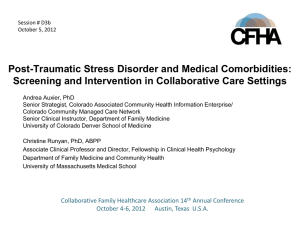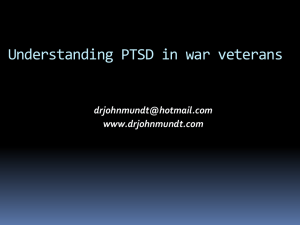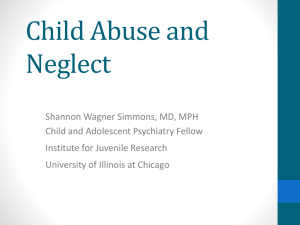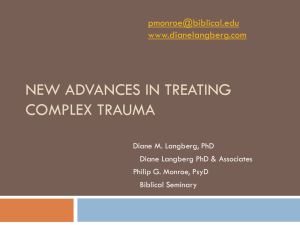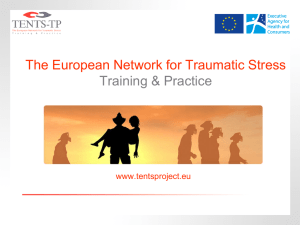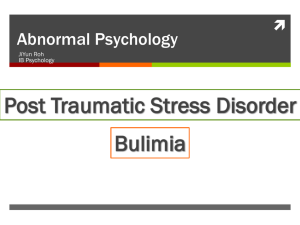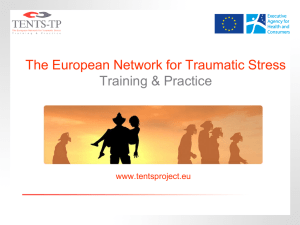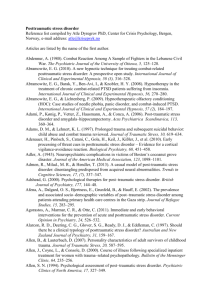View/Open
advertisement
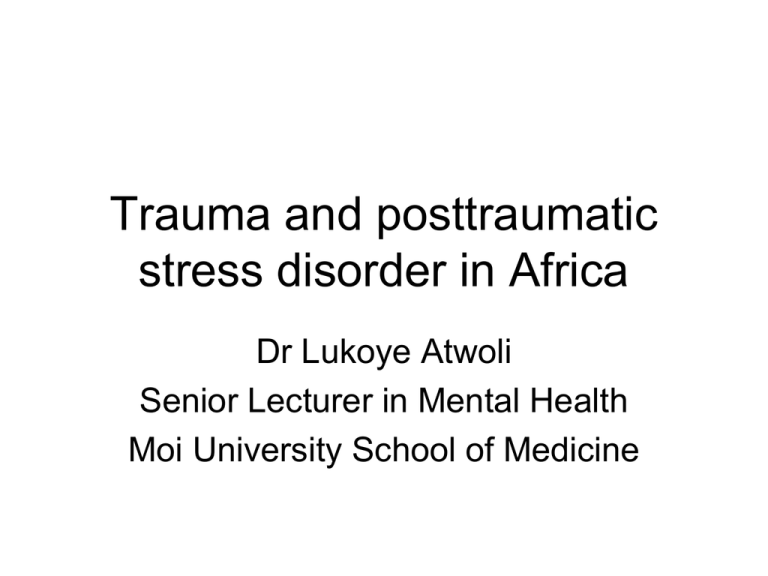
Trauma and posttraumatic stress disorder in Africa Dr Lukoye Atwoli Senior Lecturer in Mental Health Moi University School of Medicine Outline • • • • • Introduction Trauma in Africa Posttraumatic stress disorder Other posttraumatic syndromes in Africa Gaps in the knowledge: a research agenda • Conclusion Introduction • Traumatic events are a common occurrence on the African continent • Concomitant posttraumatic mental disorders disproportionately afflict Africans as a result • Africans experience suffering due to these conditions just like people in other parts of the world • Research needs to begin moving towards solutions to the problem of trauma and PTSD Trauma in Africa • Trauma rates in Africa are among the highest in the world. According to the World Health Organization, each year there are more than 200,000 road traffic deaths in Africa and perhaps 20 to 30 times as many people seriously injured. Injury rates are predicted to increase by around 80% by 2020. • Approximately 250,000 children are being abused as child soldiers in the world today (2007). Many of them, often influenced by ethnic tensions, are involved in conflicts in Africa's Great Lakes Region • In an Urban Xhosa Primary Care Population in South Africa, 94% reported exposure to traumatic events (mean, 3.8) (Carey et al. 2003) • In the South African Stress and Health Study (SASH), 73.8% of 4315 respondents reported at least one potentially traumatic event exposure. Unexpected death of a loved one, physical violence and accidents were the most commonly reported events (Atwoli et al, under review) • Over 80% of 2041 South African and Kenyan school-children reported exposure to severe trauma in a cross-national study (Seedat et al, 2004) • In the Nigerian Survey of Mental Health and Well-Being, 63% of the respondents reported exposure to at least one potentially traumatic event • In an ongoing study among orphans and separated children in Western Kenya, 77.1% of boys and 73.7% of the girls indicated that they had been bullied, among other potentially traumatic events (Atwoli et al, unpublished) • Tables 1 and 2 illustrate this more graphically OSCAR study Gender, n (%) Traumatic events Male Female P-value Sexual violence 140 (16.1) 92 (13.2) 0.11 Physical violence 297 (34.2) 155 (22.3) <0.0001 Bullying 670 (77.1) 513 (73.7) 0.12 Parent died of HIV 85 (9.8) 70 (10.1) 0.856 Type of Care Environment, n (%) Traumatic events CCI, n=746 HH, n=746 SC, n=73 P-value Sexual violence 89 (11.9) 120 (16.1) 23 (31.5) <0.0001 Physical violence 231 (31.0) 178 (23.9) 43 (58.9) <0.0001 Bullying 599 (80.3) 524 (70.2) 60 (82.2) <0.0001 Parent died of HIV 92 (12.3) 61 (8.2) 2 (2.7) 0.003 OSCAR study Criticisms of the trauma construct • Wessels and colleagues have criticised the trauma construct as “a medical model and its problematic western assumptions and foci on pathology, symptoms, and curative, therapeutic processes.” (Bracken, 1998; Eisenbruch, 1991; Kleinman, 1987; Pupavac, 2001; Summerfield, 1999, 2004; Wessells, 1999) “The trauma paradigm decontextualizes human suffering by reducing it to individual terms, when many of the greatest sources of suffering are collective and are grounded in a socio-historic context of human rights violations.” • A new focus on resilience and assets is encouraged, away from the focus on deficits • In Africa, especially, critics are arguing that “a trauma focus is less useful than a more holistic, community-based and culturally grounded approach.” • Culture is emphasised as having a bearing on concepts of suffering and trauma, precluding a universal trauma idiom • However, this critique also opens itself up for criticism, by minimising the potential of Africans to experience suffering and trauma just like their Western counterparts • It is driven by the concept of limited resources, emphasising the use of locally available resources to deal with our challenges • It is the driving force behind arguments for new models of health care delivery ‘in resource-poor settings’ Who has ever heard of ‘National Security in Resource-poor settings’? • The solution lies in designing instruments that take into consideration individual experiences as far as possible, and avoid generalising even within ‘cultures’ • The trauma construct comes as close as any other idea in mental health to defining a personal narrative of suffering In any case, what does the opening phrase- “In my culture, we (don’t)…” mean? It often means- “I would rather (not)…” Posttraumatic Stress Disorder • PTSD exists in Africa! • Since the 1940’s and 1950’s when the scientific world believed that Africans do not suffer from mental distress, we have moved on to document all psychiatric pathology that exists in mankind, on this continent • Just like the trauma concept, however, there are those who argue that the PTSD concept cannot be mapped onto the African experience High PTSD rates • In 2004, Derluyn et al evaluated clinically significant symptoms of posttraumatic stress disorder (PTSD) in former Ugandan child soldiers, using the Impact of Event Scale–Revised. The authors reported that nearly all children (97%) showed posttraumatic stress reactions of clinical importance. • Peltzer (2000) investigated trauma symptoms as a consequence of violent crime in an urban South African community and found a rate of posttraumatic stress disorder (PTSD) of 25.8% as indicated by the PTSS-10 and of 42.2% by the IES–R. • In 2006, Atwoli et al reported a current PTSD prevalence rate of 65.7% among Mau Mau Concentration Camp survivors in Kenya, about 50 years after their incarceration • Pfeiffer (2011) found that 49% of former abductees in N. Uganda suffered from PTSD, while Klasen et al (2010) reported a rate of 36% among former Ugandan child soldiers • In the urban Xhosa community in South Africa, PTSD (current; 19.9%) was among the most common diagnoses. (Seedat et al 2004) • In the OSCAR study in Uasin Gishu County, 38.3% of the 1565 children have PTSD (boys 39.2%, girls 37.1%, p=0.380) (Atwoli et al, unpublished) • Olley et al (2007) reported a PTSD prevalence rate of 14.8% among South Africans living with HIV, and concluded: • “In the South African context, PTSD is not an uncommon disorder in patients with HIV/AIDS. In some cases, PTSD is secondary to the diagnosis of HIV/AIDS but in most cases it is seen after other traumas, with sexual violation and intimate partner violence in women being particularly important.” (Olley et al 2005) Lower PTSD rates • In the SASH study, the conditional prevalence rate of lifetime PTSD was 2.3%, with a 12-month prevalence of 0.7% in the general sample • The rate among those exposed to traumatic events was 3.5% • This study used a new method of estimating community prevalence of PTSD using the ‘random event’ method (Atwoli et al, 2013, under review) • Similarly, Kamau et al in 2012 found a low PTSD prevalence rate (1.3%) among children with HIV in Kariobangi • In Nigeria, Gureje et al reported ‘virtually no generalised anxiety disorder or PTSD’ in the national study • Obviously, then, PTSD rates widely differ across the continent, and even within countries, depending on a wide range of factors • Instruments used to assess trauma and PTSD have an impact on the prevalence rates, as does the actual prevalence of potentially traumatic events • In Africa, most studies have not found the traditional association between PTSD and gender, perhaps due to the ubiquitous nature of violence and victimisation across societies Other posttraumatic syndromes • Obviously, PTSD is not the only (or the most important) outcome of exposure to potentially traumatic events • Studies have uncovered major depressive disorder as a potentially more important outcome, as well as substance use, other anxiety disorders and somatoform disorders • It has even been suggested that all these disorders are part of the same continuum of trauma-related psychiatric disorders, and may perhaps even constitute one disorder! Gaps in the knowledge: A research agenda • What is the actual population prevalence of trauma and posttraumatic mental disorders? • What role does culture play in the distribution of trauma and posttraumatic morbidity? • What are the successful methods of treating posttraumatic mental disorders in Africans? • Are there ‘African alternatives’ to proven treatments such as CBT, Trauma-focussed CBT and EMDR? • Do Africans experience trauma and distress differently from other human beings? • Are there successful African interventions for reducing the burden of violence and why haven’t Africans adopted them? The answers, as they say, are out there! Conclusion • Traumatic events are a common occurrence on the African continent • Concomitant posttraumatic mental disorders disproportionately afflict Africans as a result • Africans experience suffering due to these conditions just like people in other parts of the world • Research needs to begin moving towards solutions to the problem of trauma and PTSD, and away from arguments on construct validity



